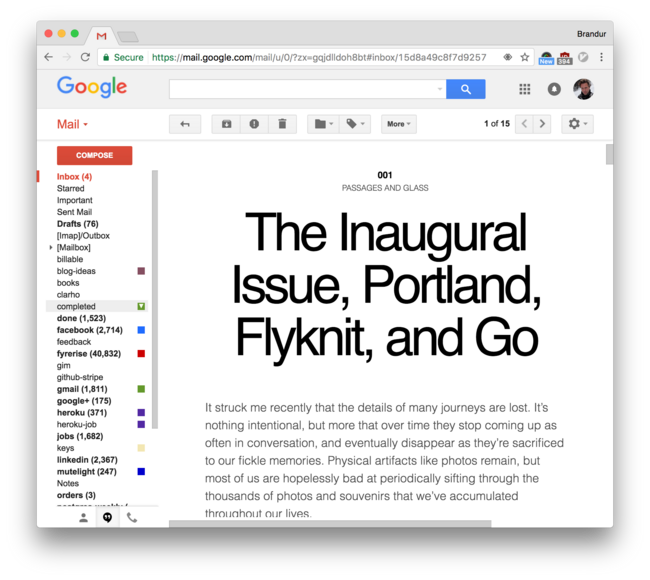Pseudo-HTML and Pidgin CSS: Building an Email Newsletter
After a recent trip to Portland, I decided to try writing a newsletter. I don’t post on Facebook or other social very often, and don’t otherwise do a good job of staying in touch with friends and family, so I’m always on the lookout for ways to develop better habits to help address that. I’ve been a subscriber to a few high quality newsletters from other people for years and reading them is something I really enjoy. Publishing my own seemed like a worthwhile experiment to the end of of doing a better job of staying connected.
As one of the holdouts who refuses to move to a centralized publishing service (or publish content exclusively to a social network), I also like the idea of supporting the independent web. Bloggers used to have a powerful distribution channel in the form of RSS, and although the technology still exists today, but it’s been fading for years, with more people moving exclusively towards their favorite social platform for content discovery. Email is a flawed technology in many ways, but it’s one of the few communication channels that every connected person in the world will reliably have, and it fully supports sending rich media (images, links, videos, quotes, etc.) over open standards, and even content more than 140 characters long.
There’s nothing revelatory here, but I’ll go through a few of the tools and services that I used, and some of the surprises along the way.
The right shape of service
Initially I assumed that the best way to go would be through one of the many newsletter services like MailChimp or TinyLetter. Maybe it is, but in all the cases I looked at they either wanted to paste a branded footer on the end of everything you send, have you use a horrible WYSIWYG editor, or both; I also wanted to archive old copies on the web somewhere, and it was looking like I’d have to reinvent a custom layer on top of whatever service I ended up using.
I sure wasn’t about to start sending email myself, so I still wanted to use a service, but kept looking for one that exposed the right primitives. I wanted pixel perfect control over the visuals, but to fully offload subscription management to someone else.
After a little more Googling I discovered that Mailgun offered an API for mailing lists. I’ve been using Mailgun for sending mail for years at Heroku, then at Stripe, and their service has been well-designed and reliable. Even better, at the email volumes that I’ll be working with I’m unlikely to ever leave the free tier, and even beyond that their prices are good. I poked around their control panel for a while and experimented by sending a few messages to myself with their Go SDK, and it was off to the races.
// Sample code working with the Mailgun SDK -- build a
// message, add HTML and plaintext content, and send away.
mg := mailgun.NewMailgun(mailDomain, conf.MailgunAPIKey, "")
message := mailgun.NewMessage(
fromAddress,
fmt.Sprintf("Passages & Glass %s — %s",
passage.Issue, passage.Title)
passage.ContentRaw,
recipient)
message.SetReplyTo(replyToAddress)
message.SetHtml(html)
resp, _, err := mg.Send(message)
if err != nil {
log.Fatal(err)
}
log.Printf(`Sent to: %s (response: "%s")`, recipient, resp)
Pidgin CSS
Over the last few decades, we’ve had pretty good success in standardizing how HTML and CSS are rendered across browsers, and during the time some huge victories were won. Progressively more sophisticated tests like Acid2 and Acid3 dragged browsers up to spec and established widespread consistency in how they render the same code. Even straggers like IE that most had deemed hopeless were made to fall in line. I’d naively assumed that this was a war that had long since been won, only to realize that on the email front, the battle’s still going, and has been quagmired for years.
Email clients are a million miles away from rendering anything that’s even remotely compliant with anything, and they’re all uncompliant in their own exotic ways. Some clients are better than others, and somewhat ironically the companies that we tend to think of as the most advanced in the world are some of the most regressive. If you threw Acid2 at Google Mail, you’d be lucky to see a lone yellow pixel on screen.
The newsletter industry has dealt with this less than
optimal state of affairs by developing a form of “pidgin
CSS” made up of the lowest common denominator of what the
world’s diverse set of clients will handle. Campaign
Monitor’s CSS support matrix does a good job of
showing just how divergent (and underwhelming) feature
support is between clients. Best practice is to keep HTML
email as basic as possible. Fancy CSS keywords like float
are best avoided, anything developed this decade like
flex and grid are totally out, and <table /> is still
the state of the art when it comes to building more complex
layouts.
I found that everything beyond the most trivially basic CSS usually caused problems in at least one mail client (often Google Mail):
<style></style>tags aren’t supported by Google Mail (meaning a very healthy fraction of all potential readers), so all CSS needs to be inlined like<p style="..."></p>.- Negative margins don’t work.
- Descendant selectors (
#wrapper p) and child selectors (#wrapper > p) can’t be used (along with most other types of selectors). - Ergonomic niceties like
remare out.
After a few false starts I fell back to a layout that
offers a maximum in the tradeoff between simplicity and
style: a single centered column. I wrote CSS in my
templates with normal <style></style> tags in my templates, and
used Douceur to inline it for email.

The architecture of a newsletter
In the spirit of minimizing the number of components that I’m maintaining, I reused the code written for this site (sorg) to render my newsletter’s HTML and archives.
During development, fswatch feeds change events to a
build executable so that I can quickly iterate on content
and design. When I’m satisfied, another executable
compiles the final HTML, inlines CSS, and generates a list
message using Mailgun’s API. By default it sends a single
initial email to my personal address so that I can vet the
content a final time and keep an eye out for any rendering
problems that might be email-specific. An additional
-live argument sends it for real.
Subscription management
Mailgun helps with list management by automatically generating person-specific unsubscribe links, but there’s no equivalent for signing up new addresses. You can add new addresses manually from their control panel, but they won’t host a form for you that allows users to subscribe.
My site is static, so I built a small form that runs as a Go executable and provides this one function. It’s a little painful that I need to run a separate service to handle this very mundane job, but it should be micro enough that I won’t have to look at it very often. I chose Go for the job because it’s got a remarkable track record for API stability and minimal upgrade churn. I’m hopeful that in ten years it’ll still be running with minimal intervention on my part.
Passages & Glass
My newsletter is called Passages & Glass. It’s a digest of many topics that interest me including travel, ideas, products, and software, but with a few more personal touches compared to what I’d put in a blog post. If this sounds like something that interests you, consider signing up to receive it. I won’t bother you often.

Did I make a mistake? Please consider sending a pull request.